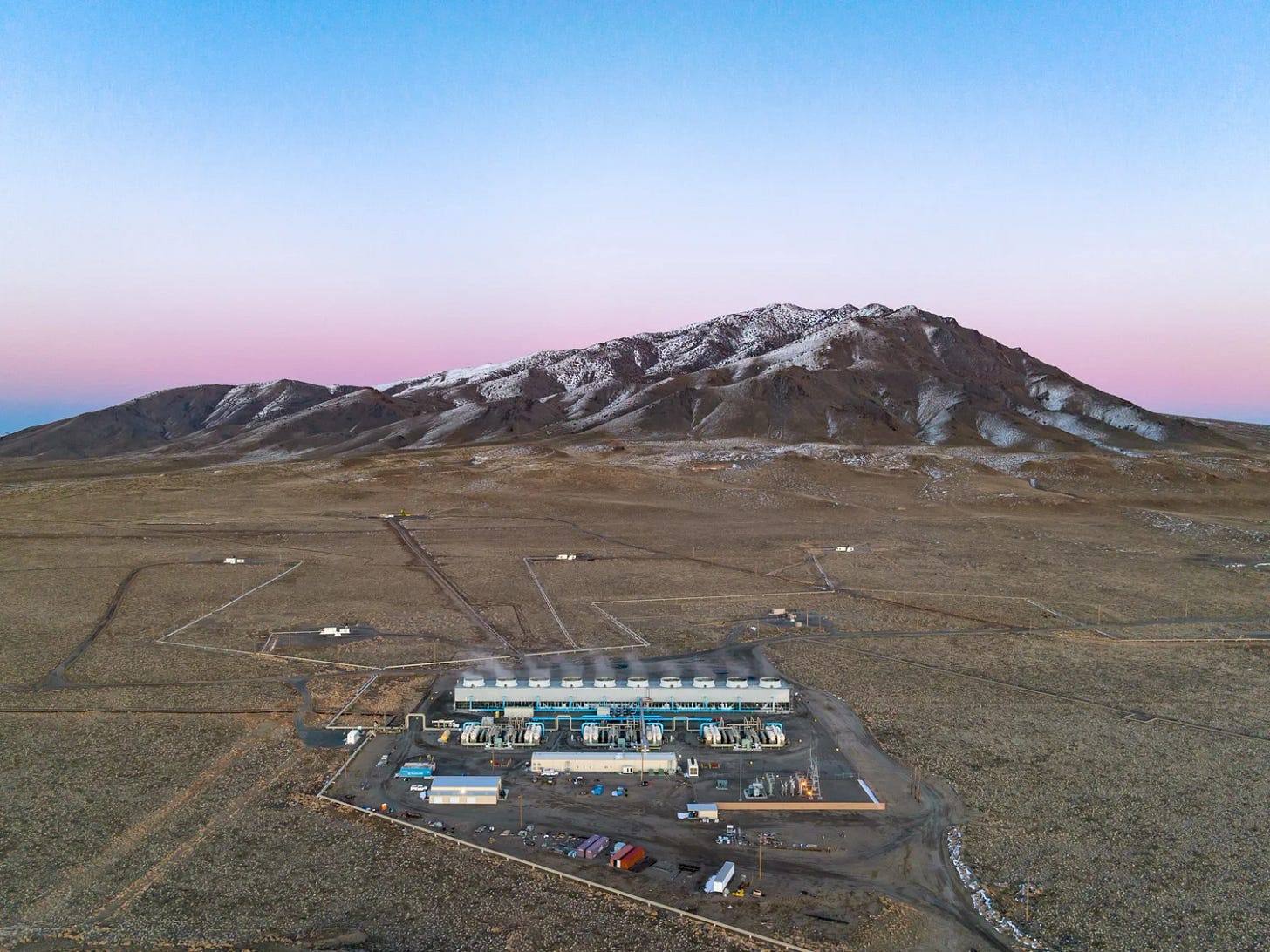How geothermal energy could drive green hydrogen production and decarbonise aviation
From magma-powered breakthroughs to scalable geothermal systems, the race is on to unlock affordable e-fuels and power a sustainable future for aviation and beyond.
In a nutshell
Geothermal energy—the earth’s heat—could unlock affordable e-fuels. A reliable, round-the-clock renewable energy source, geothermal energy has the potential to supply the vast amounts of green hydrogen needed for aviation’s transition to net zero.
Tech giants and governments are backing geothermal. Google’s geothermal projects in Nevada and Australia highlight its potential for large-scale energy needs, while the U.S. military and major airports are emerging as early adopters.
Magma Power’s bold claims. A Florida-based startup says its magma-based geothermal technology could produce green hydrogen for under $1 per kg—a fraction of today’s costs—potentially making synthetic aviation fuels economically viable.
Breakthroughs in geothermal hydrogen production. Academic research supports these claims, finding that geothermal-driven systems can produce hydrogen at costs as low as $0.97 per kg.
Scaling up to meet global demand. The aviation industry could require 16 million tonnes of hydrogen annually for e-fuels. Next-generation geothermal technologies, such as Enhanced Geothermal Systems (EGS) and superhot rock drilling, could be key to making this a reality.
Right now, in the Nevada desert, a groundbreaking project is tapping into the Earth's deep heat, producing clean energy that flows steadily, day and night, regardless of weather conditions.
Unlike sprawling solar farms or towering wind turbines that intermittently capture sunshine and breeze, geothermal energy harnesses the planet's constant internal heat.
Geothermal 101
Geothermal energy is the heat generated and stored within the Earth’s interior.
Deep wells bring hot water or steam to the surface, driving turbines to generate electricity.
Unlike solar or wind, geothermal delivers consistent, reliable power regardless of weather or time of day.
Geothermal technology has caught the attention of tech giants, notably Google, which is looking to meet the voracious demands of its AI-driven data centres. Even before the AI boom in 2023, Google's electricity consumption surpassed that of entire nations like Ghana, Croatia, and Jordan.
Google's collaboration with geothermal startup Fervo in Nevada, which has seen the opening of a geothermal power plant, demonstrates how Earth's deep heat can power energy-intensive operations. This has been followed up by a project to examine the potential for geothermal in Australia.
However, the implications extend far beyond Silicon Valley.
As aviation struggles to chart a path to net zero, geothermal energy could be a solution to produce vast quantities of green hydrogen at a cost that makes power-to-liquid (PtL) fuels (or E-fuels) economically viable.
This newest generation of Sustainable Aviation Fuels (SAF) offers CO2 reductions of up to 90% due to their green hydrogen and captured CO2 feedstocks while also potentially reducing the impact of contrails.
The challenge is that vast quantities of green hydrogen are needed. The International Energy Agency (IEA) estimates that aviation might need up to 16 million tonnes of hydrogen annually for e-fuel production, requiring considerable amounts of renewable energy for electrolysis—the process that extracts green hydrogen from water via renewable energy.
To put this into perspective, Lufthansa boss Carsten Spohr estimated that decarbonising his airline via e-Fuels would consume half of Germany's current electricity capacity.
The Magma Power breakthrough
Enter Magma Power, a Florida-based startup making the bold claim that its patented technology could produce green hydrogen for under $1 per kilogram, less than a fifth of today’s costs.
Traditional geothermal plants tap into hot water reservoirs or porous rock at temperatures up to 300°F (150°C). Magma Power's approach is fundamentally different: it aims to access magma chambers at temperatures around 2,000°F (1,093°C), potentially unlocking vastly more energy.
Speaking to Sustainability in the Air, CEO Levi Conner outlined a vision that could revolutionise both aviation and computing: geothermal power at 2-3 cents per kilowatt-hour, enabling green hydrogen production at under $1 per kilogram.
"We're building on decades of scientific research, but our approach goes further," Conner explains. "We're drilling into a much hotter environment.”
The company has secured 11 global patents and filed for 46 more, covering a process that creates a solid glass heat exchanger in magma chambers. This technology, they claim, could power everything from AI data centres to Bitcoin mining while producing green hydrogen at a fraction of current costs.
The challenges of magma-based geothermal
However, this approach remains experimental. No company has commercially harnessed magma-based geothermal power, though accidental drilling encounters in Hawaii, Iceland, and Kenya—where operations unexpectedly struck magma chambers—offer proof of concept.
Turning these accidental magma discoveries into a scalable energy solution represents an engineering challenge. Drilling directly into magma requires extreme heat-resistant materials, precision drilling techniques, and safe heat extraction methods.
Even Conner acknowledges the uncertainty: "Somebody is going to produce power from a magma chamber. It's kind of a race to the finish."
If realised, however, the potential rewards are enormous. Today’s green hydrogen costs $5-7 per kilogram, with electricity accounting for 70% of production costs.
Achieving Magma Power’s target of sub-$1 hydrogen would be a breakthrough for aviation, making clean synthetic fuels cost-competitive with conventional jet fuel.
Magma Power is currently seeking partners for over 1,000 identified global sites.
EGS: A proven geothermal solution
While Magma Power’s magma-based geothermal concept is still experimental, other next-generation geothermal technologies are already working today.
One of the most promising is Enhanced Geothermal Systems (EGS), which create artificial geothermal reservoirs by injecting water into hot, dry rock to generate steam and drive turbines.

Unlike magma-based geothermal, EGS is:
Operational – Projects like Fervo Energy’s Nevada plant prove that EGS can provide stable, cost-effective clean energy. Meanwhile, Fervo’s Cape Station project in Utah, backed by a power purchase agreement with Southern California Edison, aims to deliver 400 MW of steady geothermal power—enough to support green hydrogen production at scale.
Scalable – The U.S. Department of Energy estimates that EGS alone could provide up to 90 GW of baseload power in the U.S.
Politically supported – Geothermal energy has bipartisan support in the U.S., with the new energy secretary, Chris Wright, having personally invested $10 million in Fervo Energy through his previous company.
Cost-effective - A recent study published in the International Journal of Hydrogen Energy found that the cost of geothermal-produced green hydrogen could be as low as $0.97 per kg, making it one of the most competitive green hydrogen sources available.
While magma-based geothermal remains a longer-term bet, scaled up, EGS could help bridge the gap between green hydrogen demand and production capacity today.
Airports and military lead the way
In the aviation sector, airports and military bases are emerging as early adopters of next-generation geothermal technology, driven by their need for reliable, around-the-clock power.
The U.S. Air Force recently announced geothermal prototype facilities at Mountain Home Air Force Base in Idaho and Joint Base San Antonio in Texas. These projects, developed with Zanskar Geothermal & Minerals and Eavor Inc., aim to provide continuous clean energy, even during grid outages.
In the commercial aviation sector, Louisville Muhammad Ali International Airport (SDF) activated the largest geothermal system of any U.S. airport. The $120 million project is expected to cut the airport’s greenhouse gas emissions by 80% while saving $400,000 annually in utility costs.
European airports are following suit. Dublin Airport announced in late 2024 that it’s exploring the potential of geothermal energy, joining other airports like Paris-Orly and Copenhagen that are similarly looking into the technology.
Scaling the technology
With its potential now clear, the challenge is to scale geothermal energy fast enough to meet growing energy demands.
Project InnerSpace, a nonprofit dedicated to global geothermal development, sees today’s early adopters—airports, military bases, and AI data centres—as crucial proof points for its broader deployment.
"The core of our Earth is a molten ball of energy that is the temperature of the surface of the sun," explained executive director Jamie Beard in a recent Yale Climate Connections interview.
Beard stresses that geothermal energy needs to grow exponentially—not incrementally—to become a global clean energy solution. "We've got a hell of a lot more to do," she told Canary Media.
Project InnerSpace's analysis with the IEA suggests that next-generation geothermal technologies could provide up to 800 gigawatts of clean electricity globally by 2050—about 50 times today’s installed capacity. This would be equivalent to the combined electricity consumption of India and the United States and represent $1 trillion in new investments.
"We're at an inflexion point similar to where solar was 15 years ago," says Beard. "The technology works—now it's about driving down costs through scale and deployment."
Geothermal energy is poised for rapid growth and cost reductions.
At the same time, aviation is one of the hardest industries to decarbonise. Geothermal’s unique ability to provide 24/7, weather-independent, clean power could make it a critical piece of the solution.
Google’s breakthrough geothermal project in Nevada is just the beginning. The heat beneath our feet could help power the future of flight.




